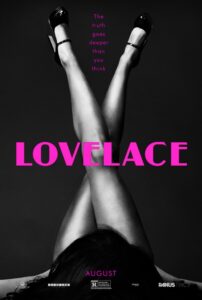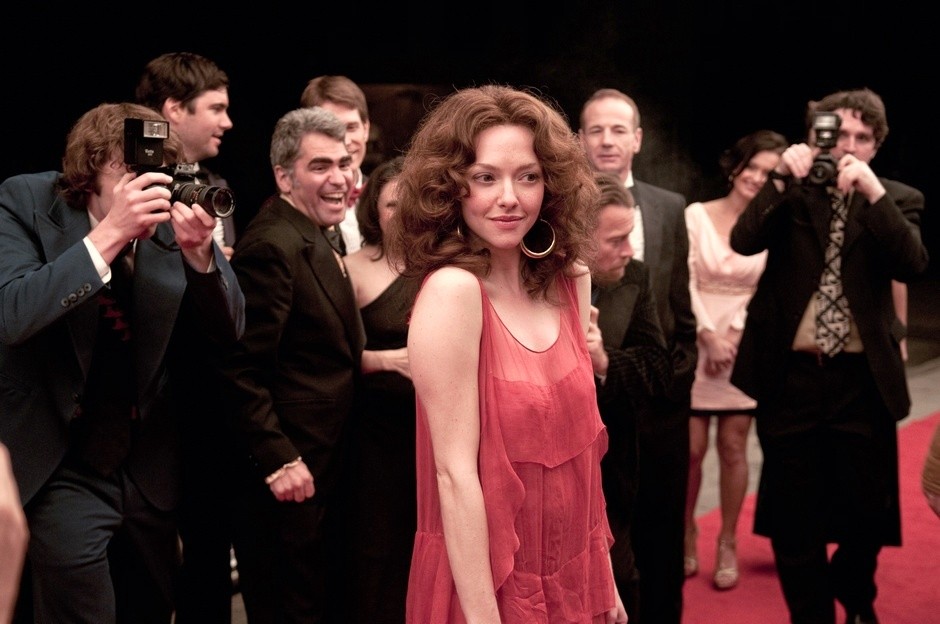 An involving if perfunctory biopic, “Lovelace” covers the life of adult film star turned anti-pornography activist Linda Boreman, better known by her screen moniker, Linda Lovelace. Lovelace was the star of “Deep Throat,” the 1972 pornographic film that was one of the first of its kind to be scripted and which Roger Ebert actually reviewed. It’s the closest hardcore pornography has come to crossing into the mainstream and grossed $100 million worldwide (or $600 million, depending on whom you believe).
An involving if perfunctory biopic, “Lovelace” covers the life of adult film star turned anti-pornography activist Linda Boreman, better known by her screen moniker, Linda Lovelace. Lovelace was the star of “Deep Throat,” the 1972 pornographic film that was one of the first of its kind to be scripted and which Roger Ebert actually reviewed. It’s the closest hardcore pornography has come to crossing into the mainstream and grossed $100 million worldwide (or $600 million, depending on whom you believe).
After enjoying a certain amount of fame, but no financial reward, Lovelace, who made a measly $1250 for her starring role in “Deep Throat,” dropped out of the adult entertainment industry in the mid-’70s. In 1980, she published her autobiography, “Ordeal,” in which she claims her abusive first husband, Chuck Traynor, forced her into adult entertainment. This led the woman to take an active role as an outspoken feminist in the anti-pornography movement.
Directors Rob Epstein and Jeffrey Friedman present two sides to Lovelace’s story. The film’s first half shows her as a shy young woman living with her parents in Florida. Here she meets a suave hustler named Chuck Traynor, whom she eventually marries. Traynor uses his shady connections to land Linda an audition with the director and producer of a pornographic film. After initially dismissing Lovelace as being too wholesome, the filmmakers are amazed when Chuck shows them a home movie, which depicts the woman’s prowess at fellatio. The rest, as the saying goes, is history.
Or at least one version of history. The film’s second half shows many of the same events we’ve already witnessed, but this time with the inclusion of the dark, violent elements Lovelace internalized until the publication of her book. Chuck Traynor turns from a regular lowlife dirtball to a menacing lowlife dirtball. In one disheartening scene, Linda visits her parents and asks her mother if she can move home to escape Chuck’s violent behavior. Instead of providing a safe haven for her daughter, Linda’s mother wonders what she did to provoke Chuck. Things only get worse for Linda.
Amanda Seyfried plays the title character with a good deal of restraint — perhaps too much. Ultimately, the film plays like a standard run through of key points in Lovelace’s life, but admittedly with a tight narrative thread. And just when the film takes a darker turn and starts to feel like Bob Fosse’s “Star 80,” all of a sudden Eric Roberts shows up. The cast has many familiar names in roles both large and small (Wes Bentley and Chloe Sevigny probably have a combined 45 seconds of screen time). Among the bigger roles, Peter Sarsgaard is creepy as Chuck Traynor, but definitely doesn’t project the same danger he did in “Boy’s Don’t Cry.” Sharon Stone is unrecognizable as Lovelace’s mother (I literally didn’t realize it was Stone until I looked at the press notes before sitting down to write this review) and James Franco plays Hugh Hefner as “weird guy” Franco rather than “funny guy” Franco. Chris Noth delivers the most convincing performance as a mobster/producer named Anthony Romano.
As compelling as the film can be at times, it didn’t pass the sleep test for me — in other words, I didn’t think much about the movie the day after seeing it. The subject matter and era naturally bring to mind the aforementioned “Star 80” and, to a larger degree, “Boogie Nights,” but whereas those films are quite memorable (even those who aren’t fans of either would probably still confess to remembering many parts of them), “Lovelace” just doesn’t have enough elements that stand out. The time period is well created, the story moves swiftly and most viewers will leave the theater knowing considerably more about Linda Lovelace, who was killed in a car accident in 2002, than they did going in, but it all feels formulaic.
“Lovelace” wasn’t a bad way to spend 90 minutes of my life, but it feels like there’s a better film to be made about this subject. Interestingly, another Linda Lovelace biopic is currently in development, so we may not have long to wait for that better film.

